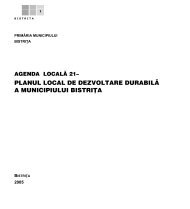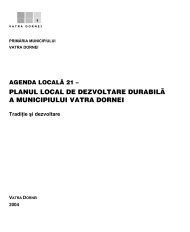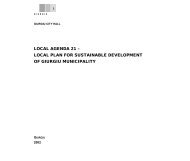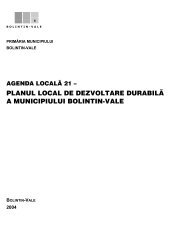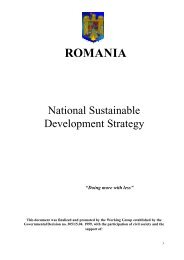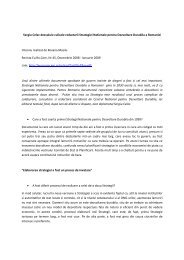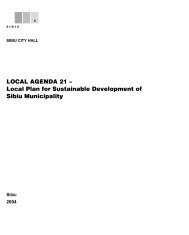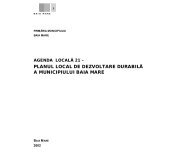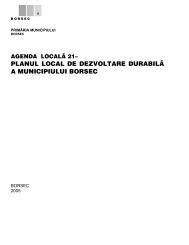local agenda 21 local plan for sustainable development of bistriþa ...
local agenda 21 local plan for sustainable development of bistriþa ...
local agenda 21 local plan for sustainable development of bistriþa ...
Create successful ePaper yourself
Turn your PDF publications into a flip-book with our unique Google optimized e-Paper software.
BISTRITA<br />
External<br />
environment<br />
83<br />
Existence <strong>of</strong> qualified teachers in Bistrita’s<br />
schools;<br />
International cooperation and twinning<br />
programmes between towns;<br />
Diversified and accessible mass-media;<br />
Existence <strong>of</strong> a Public Relations Centre within<br />
Bistrita City Hall;<br />
Existence <strong>of</strong> a Health Centre meeting European<br />
standards;<br />
Opportunities<br />
Legal provisions are in accordance with the need<br />
to stimulate employers by subsidising work<br />
places;<br />
Existence <strong>of</strong> charities and associations in the field<br />
<strong>of</strong> social protection;<br />
Favourable legislation in the field <strong>of</strong> social<br />
protection;<br />
Some fields insufficiently developed and there<br />
is high demand <strong>for</strong> services;<br />
Programmes with external financing;<br />
Implementation <strong>of</strong> PHARE VET – 2003/2004<br />
programme concerning the <strong>development</strong> <strong>of</strong><br />
vocational training;<br />
Establishment <strong>of</strong> partnerships with economic<br />
operators <strong>for</strong> the merged practical training <strong>of</strong><br />
students;<br />
Programmes <strong>for</strong> continuous training at <strong>local</strong> level,<br />
through CCD Bistrita and at regional level with the<br />
support <strong>of</strong> University Cluj-Napoca: computer<br />
literacy, <strong>development</strong> <strong>of</strong> In<strong>for</strong>mation Centres,<br />
education programmes <strong>for</strong> Rroma youth etc;<br />
Implementation <strong>of</strong> the programmes <strong>for</strong> curricula<br />
approval, <strong>for</strong> school manager training;<br />
Accession <strong>of</strong> European Programmes: Leonardo<br />
da Vinci, Commenius etc.;<br />
Introduction <strong>of</strong> in<strong>for</strong>matics into secondary schools<br />
and provision <strong>of</strong> new computers;<br />
Existence <strong>of</strong> the cultural-artistic traditions;<br />
Good inter-ethnic relations (Hungarians,<br />
Germans, Rroma) and inter-confessional relations<br />
(Orthodox, Catholics, Greek-Catholics,<br />
Evangelists, neo-Protestants).<br />
Axis 1 Increasing living standard by ensuring quality<br />
medical services, safe and healthy housing<br />
Insufficient services and programmes addressing<br />
elderly people;<br />
Low educational level <strong>of</strong> the assisted population;<br />
Precarious situation <strong>of</strong> families with many children;<br />
Low cohesion between technical bodies, pr<strong>of</strong>essional<br />
associations, experts;<br />
Sanitary system is insufficiently financed;<br />
Lack <strong>of</strong> dialogue between political actors (political<br />
parties, senators, deputies, councillors) and citizens<br />
and civil society;<br />
Lack <strong>of</strong> an adequate space and medical staff in the<br />
component <strong>local</strong>ities.<br />
Threats<br />
Resistance to the change on part <strong>of</strong> institutions;<br />
New services might have insufficient capacity to satisfy<br />
the population’s needs;<br />
Lack <strong>of</strong> alternatives <strong>for</strong> minors, mental patients etc.<br />
caused by the lack <strong>of</strong> medical-social institutions;<br />
Loss <strong>of</strong> confidence and credibility in trade unions;<br />
Drop in birth rate that affects the County Project <strong>for</strong><br />
schooling;<br />
Possible increase <strong>of</strong> absenteeism and school<br />
abandonment taking into account the actual socioeconomic<br />
conditions;<br />
Lack <strong>of</strong> psychologists in schools;<br />
Lack <strong>of</strong> involvement <strong>of</strong> <strong>local</strong> authorities in organising<br />
tenders <strong>for</strong> financing educational projects;<br />
Black market labour (tax avoidance);<br />
Mono-industrial economy, difficult conversion;<br />
Migration <strong>of</strong> adult work <strong>for</strong>ce, qualified and unqualified;<br />
Lack <strong>of</strong> work places compared with demand.



